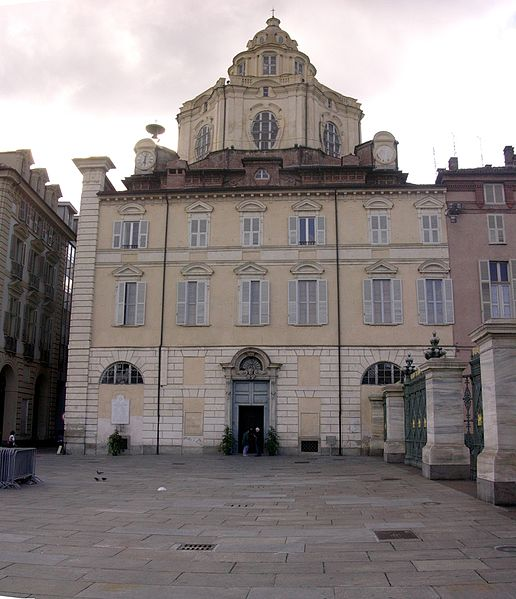Exemplary architectural gem, this Baroque chapel, the Royal Church of San Lorenzo, was built under the instruction of Duke Emmanuel Philiber (nicknamed "Ironhead" because of his military career) to commemorate a historic victory in battle.
This military triumph of Spanish and Italian forces under the Duke’s cousin Phillip II, King of Spain culminated on August 10, the feast day of Saint Lawrence (San Lorenzo) in Flanders, 1557. Helping to bring about the return of power to the Duke of Savoy of Italian territories including Turin, outlined in the Treaty of Cateau-Cambrésis (1559). Filiberto also known as Testa di ferro (Ironhead), served as a commander in the army under his cousin Phillip II of Spain. The Spanish monarch simultaneously built the hugely impressive and culturally significant El Escorial palace in the town of San Lorenzo de El Escorial, NW of Madrid. This regal historic residence also honoured Saint Lawrence and was designed to assert Catholicism across the region and anchor Spain at the heart of the Christian empire, it is the burial site for nearly every Spanish regent over the last five centuries.
The Savoy family undertook the construction of the church found at the gates to the Palazzo Reale following the death of Duke Emmanuel Philibert in 1580. Today it stands on Via Palazzo di Città, disambiguous and somewhat austere externally save it’s sheer height and crowning dome. Work began 53 years after the Duke's death in 1634. Designed by Camillo-Guarino Guarini (b.1624 – d.1683), an influential and prolific Piedmontese Baroque architect, who was also an ordained Theatine priest, mathematician and writer.
The Royal Church of San Lorenzo incorporated an older structure the chapel of Santa Maria ad Presepae, which still exists near the entrance, and was once home to the sacred Shroud of Turin. The famous relic was last displayed here in the year 2000. Guarini designed a multitude of iconic buildings across Europe, including several in Turin; the Chapel of the Holy Shroud, Palazzo Carignano and the Castle of Racconigi as well as buildings in Paris, Vienna, Prague and Lisbon.
A masterclass in Baroque-style, the interior showcases every architectural trick in the book. When put all together in this hallowed space the effect is to stupefy an audience, and this was exactly the motive of the architect through his virtuoso manipulation of 17th century design. Guarini was heavily influenced by Francesco Borromini (b. 1599 d. 1667) a ground-breaking architect of his era who designed the small but perfectly formed example of Roman Baroque architecture the church of San Carlo alle Quattro Fontane (San Carlino, Rome). Guarini in turn inspired Filippo Juvarra, whose designs permeate Turin’s grandest streets and buildings and is widely considered to be his successor.
This church is one of Guarini’s most successful projects and is noted by scholars to be a standout example of the Baroque style as a whole. The interior will dazzle you with it’s awe-inspiring architectural and decorative detailing. Patronised by notable court figures of the House of Savoy, who are artistically rendered in and amongst the many chapels - aspirationally depicted alongside saints and biblical figures.
An orthodox square central plan gives way to eight concave chapels one incorporating the High Altar. The others include; the Chapel of the Crucifix, the Chapel of the Immaculate Conception, the Chapel of the Nativity and the Chapel of the Souls in Purgatory. Guarini ingeniously geometrically aligns discreet glazed openings in sections of the roof, at seasonal equinoxes natural sunlight highlights frescoes of Jesus Christ and God as the Father, bathing the interior in an almost supernatural glow. Taking influence from Moorish architecture Guarini’s design rises on pendentives and pillars, before it reaches a confluence where eight pillars elongate to form the ribs of the vaulted cupola, creating a perfect eight-pointed star. This almost miraculous feat of human design and engineering undertook in the middle-ages remains to this day a spectacle of divine logic.
Real chiesa di San Lorenzo
Via Palazzo di Città, 4, 10122 Torino, Italy

- Monday:
-
07:30 - 12:00
15:30 - 19:00
- Tuesday:
-
07:30 - 12:00
15:30 - 19:00
- Wednesday:
-
07:30 - 12:00
15:30 - 19:00
- Thursday:
-
07:30 - 12:00
15:30 - 19:00
- Friday:
-
07:30 - 12:00
15:30 - 19:00
- Saturday:
-
07:30 - 12:00
15:30 - 19:00
- Sunday:
-
09:00 - 19:30




